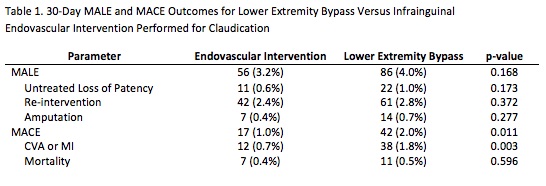Major Adverse Limb and Major Adverse Cardiovascular Events after Lower Extremity Bypass and Infrainguinal Endovascular Intervention in Patients with Claudication
Anna Z. Fashandi, MD, J Hunter Mehaffey, MD, Robert B. Hawkins, MD, Kenneth J. Cherry, MD, Margaret C. Tracci, MD, Irving L. Kron, MD, Gilbert R. Upchurch, Jr., MD, William P. Robinson, MD.
University of Virginia, Charlottesville, VA, USA.
OBJECTIVES: Major Adverse Limb Events (MALE) and Major Adverse Cardiovascular Events (MACE) at 30 days provide standardized metrics of procedural safety which have been adopted by the Society for Vascular Surgery as Objective Performance Goals for critical limb ischemia. However, 30-day MALE and MACE after lower extremity bypass (LEB) and infrainguinal endovascular intervention (IEI) for claudication have not been well described. The purpose of this study was to compare MALE and MACE after LEB and IEI and to determine the factors predictive of MALE and MACE. METHODS: A national dataset of LEB and IEI performed for claudication was obtained using NSQIP vascular-targeted participant use files from 2011-2014. The primary outcomes were 30-day MALE (defined as untreated loss of patency, reintervention, amputation) and MACE (defined as stroke, myocardial infarction, death). Multivariate logistic regression was used to identify predictors of MALE and MACE. Statistical significance was set to an α of 0.05.
RESULTS: 2,155 LEB and 1,770 IEI procedures were performed for claudication. MALE was similar in LEB (4.0%) and IEI (3.2%), (p=0.17, Table 1). On multivariate logistic regression, predictors of 30-day MALE included tibial revascularization (OR 2.2, 95% CI 1.47-3.18) and prior LEB on the same arterial segment (OR 1.8, 95% CI 1.20-2.59). MACE was significantly higher after LEB (2.0%) compared to IEI (1.0%), (p=0.01, Table 1). Predictors of 30-day MACE included LEB vs IEI (OR 2.1, 95% CI 1.17-3.76) and a history of chronic obstructive pulmonary disease (OR=2.2, 95% CI 1.17-3.99), dialysis dependence (OR=4.4, 95% CI 1.65-11.76) or diabetes (OR=1.9, 95% CI 1.09-3.16).
CONCLUSIONS: LEB and IEI for claudication are associated with equivalent MALE at 30 days. Tibial revascularization after prior failed bypass predicted MALE and should therefore be undertaken selectively for claudication. LEB was associated with higher 30-day MACE but equivalent mortality compared to IEI. In addition, chronic obstructive pulmonary disease, dialysis dependence, and diabetes predicted MACE and revascularization for claudication should be performed selectively in these patients. The risk of MALE and MACE after LEB and IEI defined in this study should be weighed against the long-term outcomes of LEB, IEI, and conservative management.
Back to 2017 Karmody Posters




